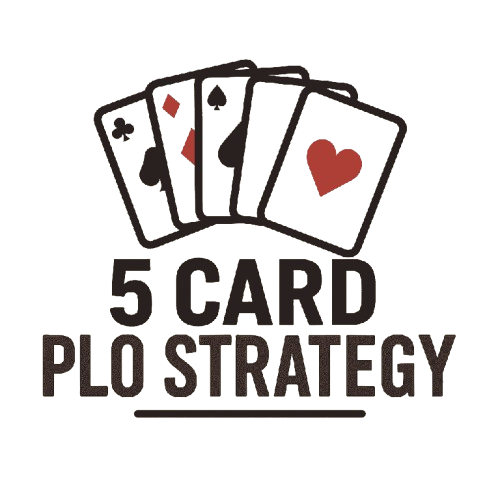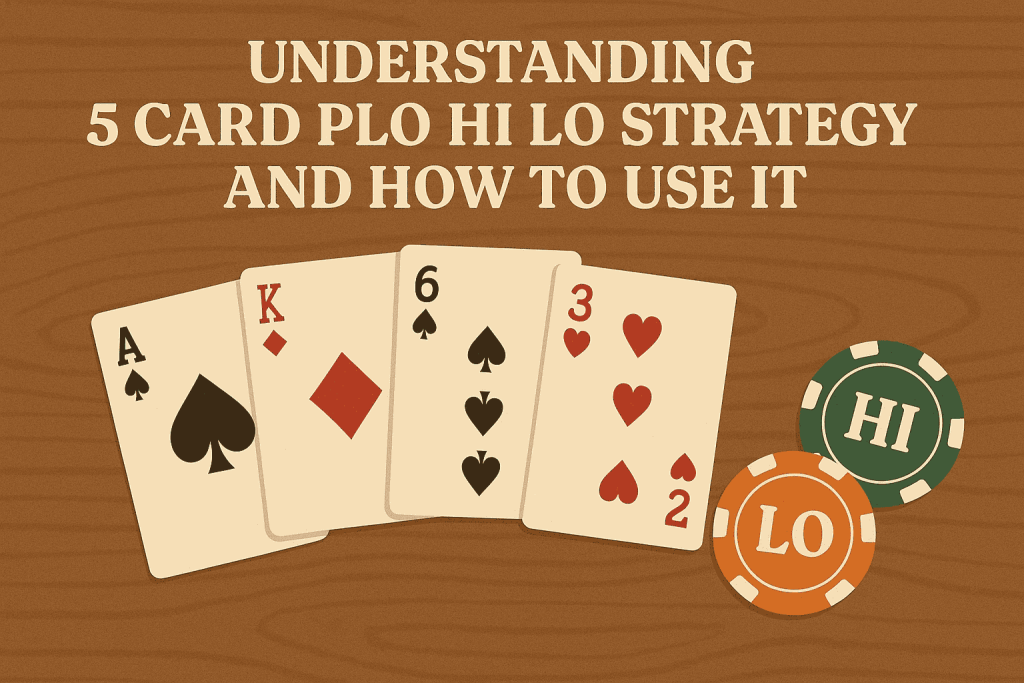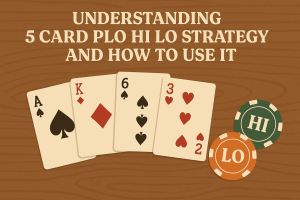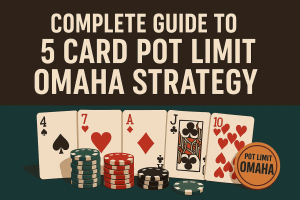The game of Pot Limit Omaha has evolved significantly over the years, with many variants capturing the interest of poker players worldwide. Among these, 5 Card PLO Hi Lo stands out due to its complex rules and highly strategic gameplay. Combining the excitement of five hole cards with the split-pot dynamic of Hi Lo poker, this variant offers both risk and reward for those who are willing to master it.
Understanding the nuances of 5 card PLO Hi Lo strategy is essential for long-term success. In this guide, we’ll explore the rules, strategies, and critical thinking required to navigate this dynamic and skill-intensive poker variant.
What is 5 Card PLO Hi Lo?
5 Card PLO Hi Lo, sometimes referred to as “Omaha Eight or Better with five cards,” is a split-pot game. The pot is divided between the highest and lowest qualifying hands at showdown. The addition of a fifth hole card significantly increases hand possibilities and therefore complexity.
This format rewards both high hands and low hands, but only if the low hand qualifies. To qualify for the low, a player must use two cards that are ranked eight or lower, and the final five-card low must consist of five unpaired cards all ranked eight or lower. Straights and flushes do not count against a low hand.
Understanding the Basic 5 Card PLO Hi Lo Rules
Before diving into strategy, players must fully grasp the rules of 5 card PLO Hi Lo. Each player is dealt five hole cards and must use exactly two of them, combined with exactly three community cards, to form their best high and low hands. The game is played with Pot Limit betting, which means the maximum a player can bet is the size of the current pot.
The pot is split equally between the best high hand and the best qualifying low hand. If no player qualifies for a low hand, the entire pot goes to the high hand. It’s also possible for one player to scoop the entire pot with a hand that qualifies both high and low.
How the Extra Card Changes Strategy
Adding a fifth hole card to traditional PLO drastically increases the number of possible combinations. This opens up more possibilities for straights, flushes, and full houses, which means that marginal high hands often lose.
Players must think not only in terms of what their current hand looks like but also how it could improve on the turn and river, and how those changes affect both the high and the low components of the pot. The fifth card increases variance but also offers skilled players more opportunities to outplay their opponents.
The Value of Playing Strong Two-Way Hands
One of the core strategies in 5 card PLO Hi Lo is to focus on hands that can potentially win both the high and the low pot. These are called two-way hands. Examples include combinations like A-2-3-4-K double-suited or A-2 with wheel connectivity.
When you consistently enter pots with hands that can scoop, you increase your long-term profitability. Splitting pots with one-way hands can sometimes be necessary, but over-relying on them will lead to marginal profits or even long-term losses.
Players should avoid playing low-only hands that are unlikely to scoop. A hand like 2-3-6-7-9 may qualify for a low but has almost no chance to win the high. In contrast, A-2-3-5-K double-suited has equity in both directions and can dominate on boards that split pots.
Positional Awareness and Its Importance
Position is crucial in all forms of Omaha, but it’s particularly vital in 5 card PLO Hi Lo due to the split-pot nature of the game. Being in late position allows you to see how the action unfolds before making critical decisions. This is valuable in determining how many players are contesting for high versus low and where your hand fits within that range.
For example, if early players are betting strongly on a board that favors high hands, and you hold a premium low draw, you might want to proceed with caution unless you also have a decent high draw. On the other hand, acting last allows you to control pot size and extract maximum value from two-way hands.
Reading the Board for Hi and Lo Potential
In 5 card PLO Hi Lo, understanding board texture is essential. You must evaluate whether the board offers low possibilities and which high hands are most likely. A board like 3-4-7 rainbow clearly allows for a low, whereas a flop like Q-J-9 suits only high hands.
Knowing when a low is not possible or unlikely can shift your strategy significantly. In such scenarios, you should value high-only hands more and be prepared to apply pressure with nut or near-nut holdings. Conversely, when the board is favorable for low hands, play cautiously with high-only hands unless you’re drawing to the nuts.
Trap Avoidance and Pot Control
A common mistake in 5 card PLO Hi Lo is overcommitting with non-nut hands. Because the pot is often split, players sometimes find themselves investing heavily only to receive half of the pot or worse—getting quartered.
For example, imagine a situation where two players have A-2 for the nut low, but only one of them has a viable high. The player with no high potential is essentially risking chips to win one-quarter of the pot. Smart players will recognize such situations and avoid heavy confrontation unless they have both ends of the pot covered.
Controlling pot size and recognizing your relative position in a hand is crucial. Bet cautiously with vulnerable one-way hands and reserve large pot-building moves for when you have nut or two-way equity.
Choosing Starting Hands Wisely
Starting hand selection in 5 card PLO Hi Lo demands discipline. Aim to play hands that are coordinated, double-suited, and have A-2 or A-3 low components. Hands with strong potential to make straights and flushes, while also covering the low, are significantly more valuable than scattered or disconnected holdings.
Do not fall into the trap of playing too many hands just because you have five cards. The strength of your starting hand needs to be able to stand up against the wide range of possibilities the extra card enables.
When to Fold and When to Apply Pressure
Knowing when to fold is as important as knowing when to bet. In situations where your draw is second-best or you are dominated by another player’s likely holdings, it’s better to let go and wait for a stronger opportunity.
On the flip side, when you hold the nuts or a hand with nut potential both ways, you should not hesitate to apply pressure. Force weaker one-way hands out of the pot and maximize your equity when you’re ahead.
Bankroll Management for Long-Term Success
Given the high variance of 5 card PLO Hi Lo, proper bankroll management is essential. Because you will experience many split pots and occasional quartered outcomes, you must prepare for fluctuations in your bankroll.
Stick to limits where you can afford to play your A-game without fear of going broke. Maintain a deep enough stack to make strategic decisions on all streets and avoid desperation plays that lead to long-term losses.
Common Mistakes in 5 Card PLO Hi Lo
Many players enter this game without fully understanding the intricacies of the split-pot structure. Common mistakes include overvaluing one-way hands, misunderstanding qualifying lows, ignoring board texture, and misjudging pot odds.
Another frequent error is chasing low draws when a high hand is likely to win the full pot. In such cases, players throw money into the pot with little to no return. Awareness and discipline go a long way in avoiding these pitfalls.
Conclusion: Mastering 5 Card PLO Hi Lo Strategy
5 card PLO Hi Lo offers one of the richest strategic experiences in poker. To succeed, you must deeply understand both the rules and the strategic nuances that make this game so complex and rewarding. Focusing on two-way hands, playing in position, and avoiding marginal spots will significantly improve your chances of long-term success.
The road to mastery requires patience, study, and consistent performance. By integrating the strategies discussed here into your gameplay, you’ll be well-equipped to navigate the many dimensions of 5 card PLO Hi Lo and become a formidable player at any table.
For more advanced insights and detailed examples of 5 card Omaha strategies, you can explore the resources at Upswing Poker.




